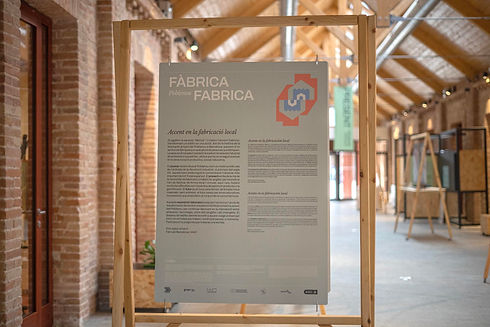BARCELONA
Mapping the wood stocks in El Poblenou’s buildings

About the pilot area
EL POBLENOU
Nestled within the vibrant city of Barcelona, the El Poblenou Neighborhood is a thriving cultural haven. The share of green space in the neighborhood is 11.6%, amidst a population density of 20,466 people per square kilometer. Due to its coastal proximity, some of the significant environmental challenges it faces include marine littering, loss of greenspace, and the increasing generation of construction and demolition waste due to the surging real estate development driven by gentrification.
El Poblenou is an important player in the city's circular ecosystem, functioning both as an innovation hub and a center of learning. At the heart of the neighborhood, you will find the La Escocesa building, a former production site for chemicals used in the textile industry.

Today, La Escocesa has transformed into a dynamic creative space and a meeting point for artists.
Fab Lab Barcelona and IAAC have set out to map local makers and wood resources in Barcelona’s former industrial hub El Poblenou to spot opportunities for a circular urban transformation. The goal of urban ecosystem mapping in El Poblenou is to showcase the wood resources hidden in the neighborhood’s urban mine and draft out policy proposals that support the recovery and reuse of demolition waste wood by local wood industries.
FOLLOW BARCELONA'S CARTOGRAPHY JOURNEY
Which insights have been gathered by our local context detectives?
Read through our gallery of local anecdotes, research findings and in-depth analysis
Parallel to Barcelona’s efforts to understand city and neighbourhood-wide urban challenges, the team has embarked on a journey to get to know the local manufacturing ecosystem - especially with a focus on the wood sector
Urban manufacturers and craftspeople
Educational institutions (Fab Labs)
Industries
Who was mapped
Why?
Creative
businesses
-
To build a strong network of makers in Poblenou
- To be able to visualise to other who is working in the area
- To map and communicate possible connections between local stakeholders
How was it useful for the Barcelona pilot team?
-
The pilot team uses their KUMU map in meetings with stakeholders to better communicate their work
- They also shared an interactive version of the maps in local exhibitions
- The process of interviewing stakeholders helped build new connections
The mapping of makers in El Poblenou was done by a dedicated team member who used an interview guide in informal conversations with makers
What local resources were mapped?
Materials
Waste streams
Tools & equipment
Used industrial processes
What else was asked?
-
Barriers to the circular economy
-
Production capacity
How was data collected?
-
Interviews, using a survey
Lessons learned
-
It is useful for our narrative to combine top-down mapping with a detailed understanding of resources and opportunities from the bottom-up
-
Customizable platforms like KUMU allow for in-depth exloration of the local context, stakeholders and circular materials
-
The methods use are helpful in weaving connections between stakeholders, materials and processes while fostering collaboration and promoting circularity in urban ecosystems
Which circular opportunities did we find for Barcelona's productive community?
Opportunities for a circular wood economy
-
Saw dust for 3D experimentation in Fab Labs
-
Wood chips for urban gardens
-
Wood waste for material development
-
Storage and recovery of demolition wood
Fab Lab Barcelona has organized roundtable discussions at the POBLENOU FÁBRICA exhibition in which the opportunities for local wood reuse were explored together with Guild associations of furniture makers, wood workers, urban planners and researchers. Public panels with experts and stakeholders are a great way to exchange ideas, build new partnerships but also identify the practical challenges of a local circular wood economy.

Showcasing possible wood waste reuse synergies at the POBLENOU FÁBRICA exhibition
Hungry for more? The CENTRINNO Living Archive collects local stories & histories on Poublenou's makers & their experience. Here, you'll find stories on women in wood, biomaterial innovators, jewelry makers or wood carvers.
GALLERY
 |  |  |
|---|---|---|
 |  |  |
 |


